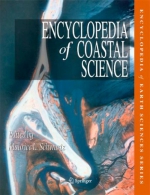Добрый день, Коллеги. Важное сообщение, просьба принять участие. Музей Ферсмана ищет помощь для реставрационных работ в помещении. Подробности по ссылке
Encyclopedia of Coastal Science
Map measurements of the world’s coastline length have yielded a figure of 500,000 km. However, when all of the very real and intricate coastal crenulations are considered, the actual length is probably closer to 1,000,000 km. Added to this is the fact that 40% of the 6,000,000,000 people presently inhabiting the earth live within 100 km of a coastline. From these observations, it can be seen that coasts are a very major geo-morphic and social feature on the face of the planet. And for this reason, scholars in a multitude of disciplines have long been studying the many facets of the zone where the land meets the sea.
In this collected volume, authorities in many fields expound on certain aspects of their expertise, not so much in a dictionary of terms sense as in a series of essays that may be broken down into such categories as: atmosphere and oceanography, ecology, engineering and technology, geomor-phology, and human activities related to the coasts (see Appendix 6: Topic Categories). The reader may not completely agree with some of their views; in fact, some of the authors do not agree entirely with each other. Perusing through professional journals in these fields would show the same variety of opinions on a given topic. For that is the nature of science, holding forth on a subject as interpreted by long and careful study of the evidence. What is then to be found here, between the covers of this volume, are 306 entries that contain a wealth of information on different aspects of the world’s coast, which we all hold so dear. If there are any questions of omissions or judgment, the fault then lies entirely with me, the editor.
In a similar vein, one would expect the terminology of a science to have universal acceptance; but, sadly, that is not the case. For example, the ubiquitous term “shoreline” can be employed in the historical geomorphic sense of the line formed by the edge of the water against the land as it rises and falls through tidal cycles or atmospheric changes; or as it has been defined by the US Coast and Geodetic Survey for mapping purposes as the high-tide line, high-water line, or wet–dry boundary. In order for the term to mean the same thing wherever it appears in this volume the geomorphic meaning has been adopted, or clarified where it has deviated from that. For further clarification of this dichotomy, the reader is referred to the entry titled Coasts, Coastlines, Shores, and Shorelines.
Though there have been many trials and tribulations during the four to five years that it has taken to bring this volume to publication, there have also been moments of humor that lightened the load along the way. While explanations for late contributions ran rampant, none was more acceptable than that from the contributor down-under who, while working on a major topic, brought forth two “bubs” (a girl and a boy) to add to an already large family. For sheer inventiveness to a contributor who did not want to repeat a previously published survey, that progressed around a continent in a clockwise fashion, there was your editor’s suggestion that he simply proceed in a counter-clockwise direction. In the end it came out only halfway there. Then too, probably the best single line in any entry contained here is the quote to the effect that a certain coastal feature is “… rather like pornography—difficult to define, but you know it when you see it!” That could only be topped by correspondence from another down-under contributor who used wildly colorful expressions that can not even be repeated here.
Of course, I am most appreciative to all of the very many people who have been involved in this project. However, two individuals stand out most significantly. The first and foremost is the editor-in-chief of this earth-science encyclopedia series, Rhodes Fairbridge, who has been my teacher, mentor, and friend for the past 40 years. The second is Peter Binfield, my editor at Kluwer Academic Publishers, who has guided me through this project with expertise, patience, and humor. To both of these gentlemen, I offer my most profound gratitude. Thanks are also due to Russ Burmester, Vicki Critchlow, Gene Hoerauf, Larry Palmer, Kevin Short, and Chris Sutton, at Western Washington University, for considerable technical support.
Sadly, media specialist Kevin Short, who worked his computer magic on many graphics in the volume including the cover photo, passed away suddenly in January of 2004 at the age of 44. Colleagues and friends alike will miss Kevin and remember him for his kindness, humor, and creativity.




